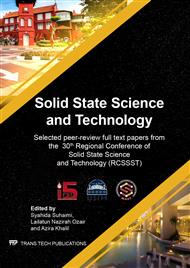p.136
p.143
p.149
p.154
p.160
p.166
p.171
p.179
p.185
Electrical Conductivity of Y3+ Doped Ba(Ce,Zr)O3 in Wet N2 Atmosphere Prepared with the Addition of Brij-97
Abstract:
Y-doped barium cerate-zirconate ceramic oxide is proven to be a competent material as an electrolyte with high proton conductivity as well as chemical and mechanical stabilities in carbon dioxide and water vapour atmospheres. This ceramic oxide requires high processing temperature which will results in the increase of particle/grain size. Hence, modification on the synthesis route has been studied in reducing the particle/grain size of the ceramic by lowering the calcination temperature. In this work, BaCe0.54Zr0.36Y0.1O2.95 (BCZY) powder was synthesized with addition of surfactant (Brij-97) through an established modified sol-gel route. Single BCZY perovskite phase was successfully obtained at calcination temperature of 950°C which was lower than our previous study (T=1100°C). The prepared sample was made into pellet by a dry pressing technique with diameter, d=13 mm and thickness, t~2 mm and then subjected to a two-step sintering method prior to morphological and electrical measurements. Impedance measurement was carried out at intermediate temperatures (500-800°C) using an Electrochemical Impedance Spectroscopy (EIS) in wet nitrogen atmosphere. Impedance spectrum was analysed to obtain the behaviour of grain core and grain boundary responses by a fitting procedure using a brick-layer model. Scanning electron microscope (SEM) analysis of fractured pellet revealed that BCZY prepared with the assisted of Brij-97 exhibited dense, homogenous and less agglomerate grain with grain size around 88 nm, which may explain the enhancement in the total conductivity of the BCZY electrolyte.
Info:
Periodical:
Pages:
160-165
Citation:
Online since:
July 2020
Keywords:
Price:
Сopyright:
© 2020 Trans Tech Publications Ltd. All Rights Reserved
Share:
Citation:


